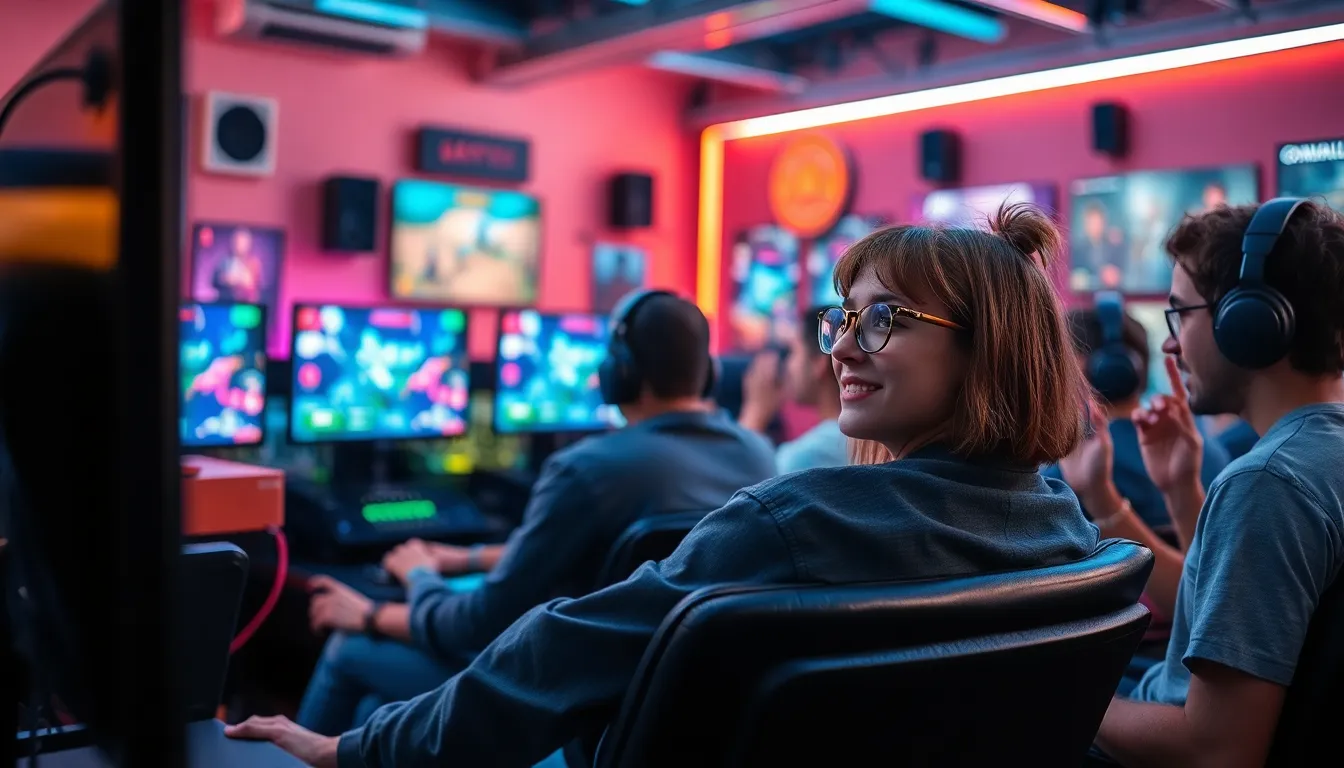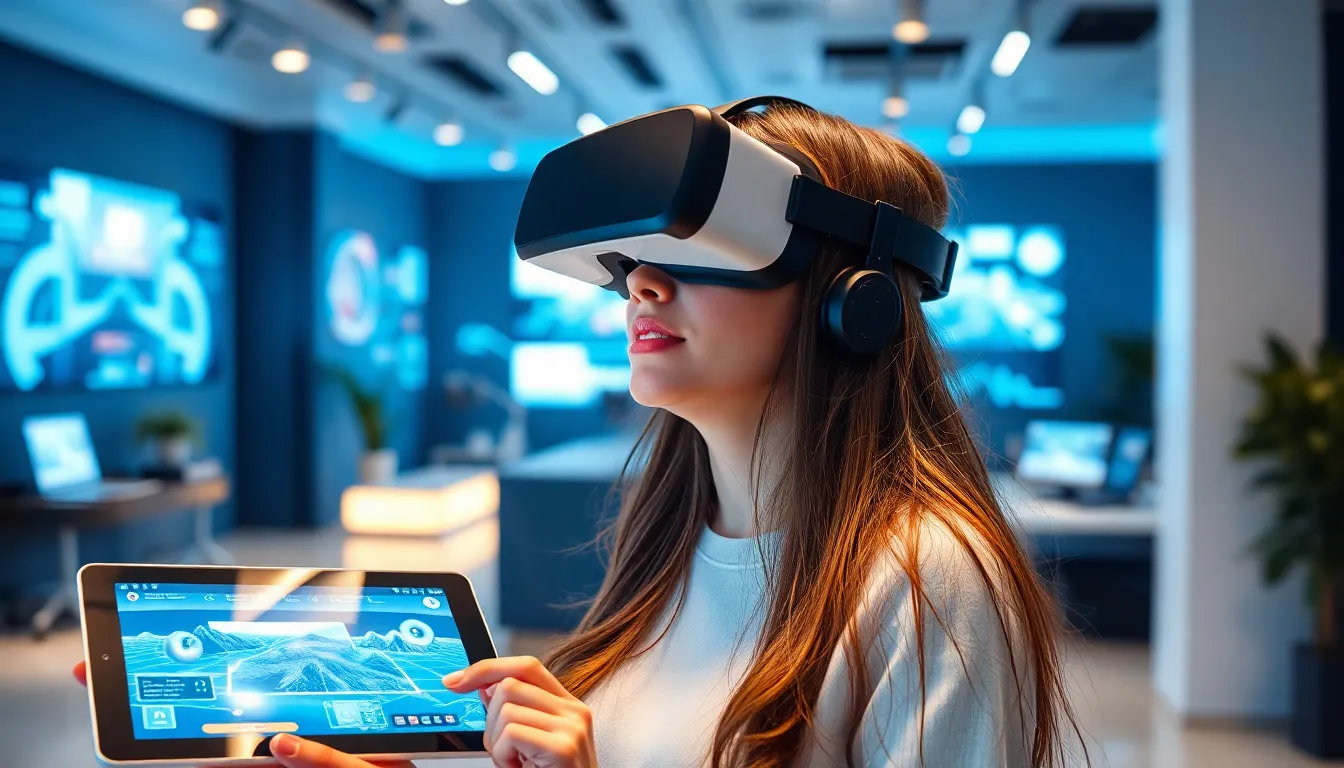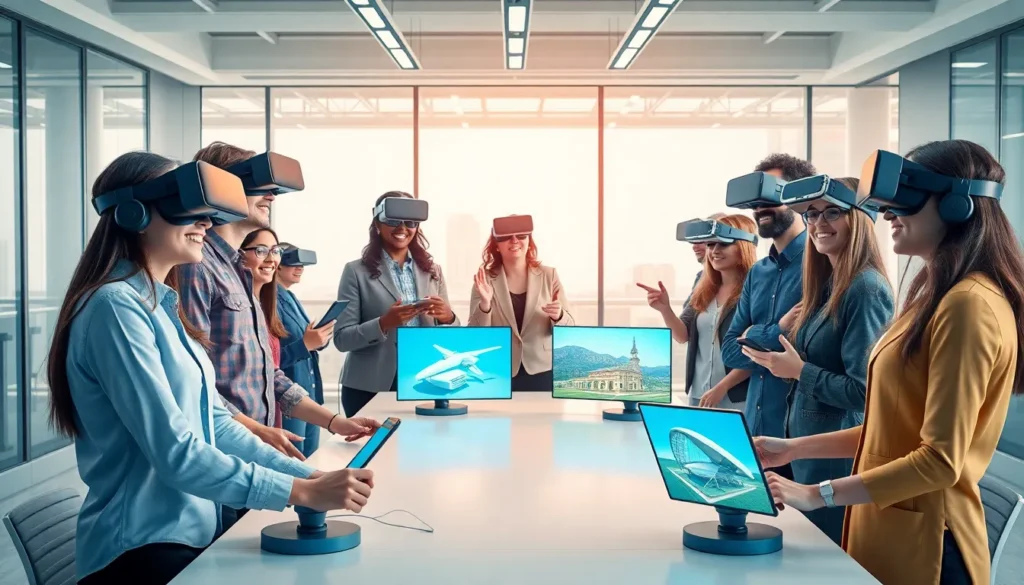Table of Contents
ToggleIn a world where reality sometimes feels a bit too mundane, augmented and virtual reality are here to spice things up. Imagine stepping into a game where you’re not just a spectator but the hero battling dragons in your living room. Or picture using your smartphone to overlay digital furniture in your actual home before making a purchase. AR and VR application development services are the magic wands turning these dreams into reality.
Businesses are catching on, realizing that engaging customers in immersive experiences can boost sales and brand loyalty. From gaming to real estate and beyond, the potential is limitless. So why settle for boring when you can leap into the extraordinary? Let’s dive into the fascinating world of AR and VR and discover how these innovative services can transform not just experiences but entire industries.
Overview of AR VR Application Development Services
AR and VR technologies transform user experiences by creating immersive environments. Businesses leverage these innovations to enhance interactivity and engagement across various sectors.
What Are AR and VR Technologies?
AR overlays digital elements onto the physical world, enhancing real-time interactions. VR, by contrast, immerses users in completely virtual environments, isolating them from their surroundings. Both technologies utilize advanced hardware and software to create these effects, enabling applications ranging from gaming to education.
Importance of AR VR in Modern Applications
AR and VR play crucial roles in modern applications, driving customer engagement and enhancing learning experiences. Businesses report increased sales and brand loyalty through immersive advertising and user interfaces. Industries such as real estate benefit from virtual property tours, while training programs utilize VR for realistic simulations. This versatility underscores the importance of AR and VR in shaping the future of technology and user experience.
Key Services Offered

AR and VR application development services encompass various key offerings tailored to meet diverse business needs. These services enhance interactivity and provide immersive experiences across industries.
Custom AR VR Application Development
Custom AR and VR application development focuses on creating tailored solutions that meet specific business objectives. Developers analyze user requirements to design engaging experiences that reflect brand identity. Solutions can range from mobile applications to comprehensive enterprise systems. By integrating cutting-edge technology, these applications ensure seamless performance across devices, enhancing user interaction.
AR VR Content Creation
AR and VR content creation plays a crucial role in delivering immersive experiences. Designers craft high-quality visuals, animations, and narratives that captivate users. They utilize advanced tools to produce realistic simulations and engaging storylines. Each content piece aligns with the overall application goals, ensuring effective communication and connection with the audience. Furthermore, diverse industries such as gaming and education benefit significantly from well-produced content.
Consulting and Strategy
Consulting and strategy services provide businesses with the expertise needed to leverage AR and VR effectively. Professionals assess market trends and identify opportunities for integration within existing operations. They develop strategic roadmaps that align with organizational goals, promoting technology adoption. By offering insights and best practices, consultants help organizations navigate challenges while maximizing ROI from AR and VR initiatives.
Industries Benefiting from AR VR Solutions
Various industries are harnessing the power of AR and VR technologies, driving significant advancements and improving user experiences.
Healthcare
Healthcare professionals utilize AR and VR for enhanced training and patient care. Surgical simulations offer practitioners immersive environments, allowing them to perfect their skills without risk. Patients benefit from AR visualizations that explain complex procedures, improving understanding and alleviating anxiety. Many organizations incorporate VR therapy to treat conditions such as PTSD and phobias by creating controlled, immersive environments where patients confront their fears. Statistically, studies show that training with VR can reduce error rates in surgical procedures by up to 30%. These innovations elevate healthcare standards while fostering better patient outcomes.
Education
Educational institutions leverage AR and VR to create interactive learning experiences. Students engage with dynamic content, which allows them to visualize complex concepts in real time. For instance, history lessons become more engaging through AR simulations of historical events. Certain universities implement VR labs, providing virtual experiments that promote engagement and retention of knowledge. Research indicates that students retain information 30% better when using these technologies. As a result, education transforms, promoting deeper understanding and increasing student enthusiasm.
Gaming and Entertainment
Gaming and entertainment industries have increasingly adopted AR and VR to create immersive experiences. This shift enhances player engagement through realistic environments and interactive gameplay. Popular games allow players to explore vast, detailed worlds that respond to their actions, captivating audiences for longer periods. Live events utilize VR to offer spectators immersive viewing experiences that transcend traditional formats. The success of franchises using these technologies demonstrates their impact on user engagement, contributing to an estimated 40% increase in revenue for leading companies. Overall, AR and VR are revolutionizing how people connect with entertainment.
Challenges in AR VR Development
AR and VR development faces several challenges that impact the effectiveness and adoption of these technologies.
Technical Limitations
Hardware constraints remain a significant barrier. Many devices struggle with processing power, limiting the complexity of applications. High-quality graphics require advanced capabilities, which smaller devices often can’t deliver. Latency issues also affect real-time interactions, resulting in user discomfort. Developers must navigate compatibility across various platforms, leading to increased complexity. Moreover, maintaining an immersive experience while optimizing performance poses a challenge, as developers seek to enhance realism without sacrificing responsiveness.
User Experience Considerations
User experience plays a critical role in AR and VR applications. Designing intuitive interfaces is key for seamless navigation. Users often face difficulties adjusting to new environments, which can lead to frustration. Effective onboarding processes mitigate this issue by guiding users through initial interactions. Accessibility options are vital, ensuring everyone can engage with the technology. Additionally, understanding user preferences and expectations influences content creation, as personalizing experiences increases engagement and satisfaction. Addressing these user-centric challenges significantly enhances the overall effectiveness of AR and VR applications.
Future Trends in AR VR Development
AR and VR technologies are evolving rapidly, with exciting trends shaping their future. These advancements promise to enhance experiences and broaden applications across various fields.
Integration with AI and ML
Artificial Intelligence (AI) and Machine Learning (ML) are revolutionizing AR and VR applications. Facilitating real-time data processing, these technologies enable more personalized experiences. For instance, AI algorithms analyze user feedback to tailor content, making interactions feel unique. Additionally, machine learning enhances object recognition within AR, improving accuracy for applications like retail and navigation. Combining these technologies creates environments where users actively engage with intelligent virtual elements, ultimately driving greater user satisfaction and effectiveness.
Advancements in Hardware
Hardware improvements significantly impact AR and VR development. Recent trends include lighter and more powerful devices, enhancing portability and usability. For example, advancements in graphics processing units (GPUs) lead to richer visual experiences. Next-generation headsets feature higher resolutions and wider fields of view, creating a more immersive feel. Innovations like gaze tracking and gesture recognition also enhance interaction possibilities, making experiences intuitive. Consequently, these hardware upgrades increase accessibility and promote wider adoption among users in various sectors.
The potential of AR and VR technologies is immense and continues to grow. As businesses leverage these innovations, they’re not just enhancing user experiences but also driving significant advancements across various sectors. The integration of AI and machine learning will further personalize interactions and improve usability.
With ongoing developments in hardware and software, the future of AR and VR application development services looks promising. Companies that embrace these technologies will likely gain a competitive edge, fostering deeper customer engagement and loyalty. Exploring these immersive solutions could be the key to unlocking new opportunities and transforming industries for years to come.







